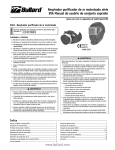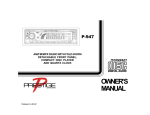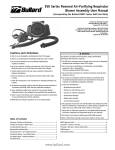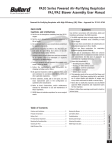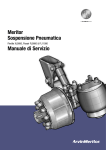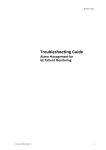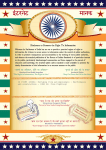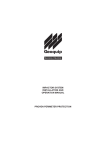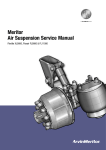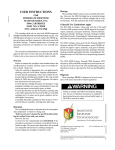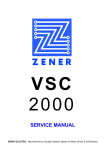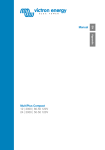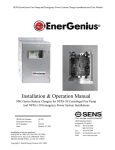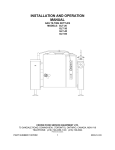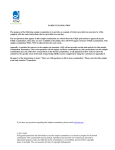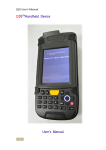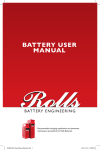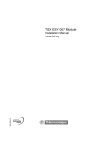Download FlexAir™ Powered Air Purifying Respirator
Transcript
FlexAir™ Powered Air Purifying Respirator www.imresponse.com Immediate Response Technologies, Inc. 7100 Holladay-Tyler Road Glenn Dale, MD 20769 800-598-9711 P/N C-85090-001, Rev. 9 This manual could contain technical inaccuracies or typographical errors. Updates are made periodically to the information herein. If you have comments please forward them to Immediate Response Technologies . Thank you. FlexAir™ Powered Air Purifying Respirator TABLE OF CONTENTS 1.0 2.0 3.0 4.0 5.0 This product shall not be used until the end user reads and understands the user instruction or instruction manual which is supplied with, and is a critical component of, each Immediate Response Technologies system. If the end user has questions concerning the safe operation of this product, please consult the local supervisor or safety program administrator. If the user instruction or instruction manual is not supplied to the end user, a copy can be obtained by calling Immediate Response Technologies: 301352-8800 (in Maryland) or 800-598-9711 (toll-free in the continental U.S.A.) Use of Immediate Response Technologies equipment, other than in compliance with the supplied user instructions, or instruction manual, or use by personnel who are unqualified, or untrained, is dangerous, and the user may be exposed or serious bodily injury or death. This respirator cannot not be used in oxygen-deficient (less than 19.5% oxygen) atmospheres. This respirator cannot be used in atmospheres that are Immediately Dangerous to Life or Health (IDLH). If the end user has questions concerning the safe operation of this product, please consult the local supervisor or safety program administrator. DuPontTM Tychem® QC and Tychem ® SL are registered trademarks of E.I. DuPont de Nemours and Company 5.1 5.2 5.3 6.0 6.1 6.2 6.3 7.0 8.0 9.0 10.0 10.1 10.2 Page GENERAL ............................................................................................... 1 CONTENTS ............................................................................................ 1 LIMITATIONS OF USE .......................................................................... 1 TECHNICAL INFORMATION ............................................................... 2 BEFORE USING THE FLEXAIR™ ......................................................... 3 - Installing the Waist Belts ..................................................................... 3 - Charging the Battery ............................................................................ 3 - Airflow Test .......................................................................................... 4 - Installing the Filtration Media .............................................................. 4 - Airflow Test (Filtration Media Installed) .............................................. 6 USING THE FLEXAIR™ SYSTEM ......................................................... 6 - Donning the FlexAir™ Blower ............................................................. 6 IN USE FLOW TEST .............................................................................. 8 AFTER USE ............................................................................................ 9 - Doffing theFlexAir™Blower ................................................................. 9 MAINTENANCE AND STORAGE ....................................................... 10 CLEANING THE RESPIRATOR ........................................................... 10 CHARGING THE BATTERY ................................................................. 11 STORING THE RESPIRATOR .............................................................. 11 DISPOSAL OF FILTRATION MEDIA AND BATTERIES .................... 12 SERVICE ............................................................................................... 12 CONSTRUCTION ................................................................................. 13 ACCESSORIES AND FILTER MEDIA ................................................. 13 ACCESSORIES ..................................................................................... 13 FILTER MEDIA .................................................................................... 14 APPENDICES APPENDIX A-------NIOSH APPROVAL LABELS.................................................... .15 © 01/10 by Immediate Response Technologies, Glenn Dale, Maryland. All rights reserved. 1.0 GENERAL • The user must be properly fitted to the respirator head cover before use. The Immediate Response Technologies FlexAir™ respirator is a blower-assisted airpurifying respirator referred to as a Powered Air-Purifying Respirator or a PAPR. • The Blower, with filtration media installed, must be tested with the Airflow Indicator, both prior to use, and at prescribed intervals during use to monitor battery life and Cartridge or Filter efficiency. The filtering system consists of a waistmounted battery-driven Blower Assembly that can be configured with three (3) gas/ particulate removing cartridges or two (2) high efficiency (HE) particulate filters. The Blower Assembly contains an electric motor driving an air blower. The Blower Assembly includes an on-board rechargeable 7.4-volt (nominal) Lithium-ion Battery (7 to 8 hour run time) and integral charging connection. A single-speed “on-off” switch is located on the top front of the Blower Assembly, with integral Low- Flow and Low- Battery alarms. There are three (3) female threaded inlets on the Blower Assembly for the attachment of the filtration media (sold separately). A blanking plug is used to block one filter port when using the two HE Filters. The user of the respirator breathes ambient air after the air has passed through the filtration media. The Cartridges includes a sorbent bed of impregnated activated carbon to trap and/or neutralize various gases/vapors, and a mechanical filter to trap airborne particles. The HE Filter comprises only a mechanical filter medium to protect against airborne particles. The Immediate Response Technologies FlexAir™ can only be used with Immediate Response Technologies head covers (see the NIOSH aproval label for specific part numbers and limitations). 2.0 CONTENTS The Immediate Response Technologies FlexAir™ filtering system can be shipped with the components listed below. Inspect the contents for shipping damage and ensure all components are present. • Immediate Response Technologies FlexAir™ Blower Assembly w/On-board Battery • Loose-fitting Head Cover • Breathing Tube Assembly • Waist Belt • Li-ION Battery Charger • Filtration media • Blanking Plug • Airflow Indicator • Instruction Manuals (with NIOSH information) The Blower Assembly assists breathing by drawing air through the filtration media and delivering the purified air through a hose assembly that is attached to the headcover. An Airflow Indicator, Immediate Response Technologies P/N S-30112-001, is used to check for minimum airflow and is provided with the FlexAir™ filtering system. To maintain respiratory protection, 3.0 LIMITATIONS OF USE As specified on the appropriate NIOSH Approval Label supplied with the Blower Assembly system, Cartridges, Filters and in Appendix A of this manual. 1 • The FlexAir™ respirator may not be taken into or used in atmospheres containing flammable or explosive gases, vapors, or dusts when the concentration of such contaminants is near or above the lower flammable limit (LFL). This powered air-purifying device is only for use in specific atmospheres and under certain conditions. Follow these instructions carefully. Failure to do so could result in injury or death. • Do not use the FlexAir™ respirator for fire fighting, in oxygen-deficient atmospheres, or for protection against airborne contaminants which the selected cartridge does not protect against. • The end user must read and fully understand this instruction manual prior to use. • The end user of the respirator must have received training in the use of the respirator including, but not limited to, pre-use check, donning, use, doffing (removal), and after-use care of the respirator. • Airflow: the FlexAir™ blower provides a constant filtered airflow at a minimum of 170 lpm to the applicable head cover when used with Immediate Response Technologies filtration media and a charged battery. NOTE: during initial system startup, the alarms will sound momentarily. If the alarms fail to cease sounding, do not use the FlexAir™ Blower until the fault is found and corrected. If the fault cannot be determined, remove the FlexAir™ blower from service and contact Immediate Response Technologies for repair. • The FlexAir™ blower may be configured with three (3) Gas/Particulate Cartridges or two (2) HE Filters and one (1) Blanking Plug. The Blanking Plug (available in black or gray) is used to manage air flow when the blower is used with the less restrictive HE Filters. • Battery: on-board rechargeable 7.4 volt (nominal) Lithium-ION (7 to 8-hour run time). NOTE: Run times will vary depending on combination of headpiece and filtration media used. Contamination levels and filter loading will also effect run time. • The FlexAir™ blower has a “soft” start feature. When the switch is depressed to the “ON” position, it will take approximately 5 seconds for blower activation. During this period the alarm will “pulse” (i.e. beep) to confirm blower activation. • Weight: Blower Assembly, with Belt Assembly, Battery and three Cartridges: approximately 4.3 lbs. 4.0. The failure to choose a respirator equipped with a cartridge and/or filter suitable for the contaminant(s) in the atmosphere or likely to be released in the atmosphere may result in the respirator providing little or no protection against the contaminated atmosphere, leading to serious bodily injury or death. • During use of this respirator, the atmosphere must be monitored for the level of contamination and provide for the withdrawal of the using personnel in the event that the contamination level increases to immediately dangerous to life and health (IDLH) levels. • This respirator must be properly inspected before use, properly decontaminated, if necessary, after use, properly cleaned and maintained after use, and properly stored between uses. 2 • Low-airflow alarm: the FlexAir™ incorporates an audible “continuous” alarm that activates when the system air flow falls to a level where the end user MUST leave the contaminated environment immediately, and decontaminate if necessary. If continued system use and reentry is required, the cause of the low flow alarm must be determined (for example, clogged filtration media, obstructed hose), corrected, and the system checked for proper operation. TECHNICAL INFORMATION • Low-battery alarm: the FlexAir™ incorporates an audible “pulsing” alarm that activates when the system battery voltage is approaching a low level and the end user MUST leave the contaminated environment immediately and decontaminate if necessary. Charge the onboard battery before reusing the system. 5.0 • Perform all required pre-use inspections, checking the condition and intactness of all components. - Installing the Waist Belts 1) Note the lacing path of the belt through the male buckle and remove the male buckle and keeper loop from the end of the belt. 2) Thread the belt through the slot on the blower side and out through the adjacent slot on the blower back plate; across the back of the blower; and then down through the slot on the back plate and out the side slot. Center the blower on the belt. 3) Replace the keeper loop and lace the male buckle back onto the belt. - Charging the Battery • The FlexAir™ Blower has an on-board battery that must be charged before initial use and after each use. • Use only the approved Immediate Response Technologies Lithium-Ion charger to charge the FlexAir™ blower. BEFORE USING THE FLEXAIR™ Failure to use the approved charger and/ or follow the proper charging procedure could damage equipment or lead to serious bodily injury. • See “Instructions for Use” of the respective Head Cover. • Use only those NIOSH-approved Immediate Response Technologies Cartidges, Filters and Head Covers listed on the NIOSH approval labels (see Appendix A). Use three Cartridges or two HE Filters and a Blanking Plug. • The battery should be charged in dustfree area at a temperature between 32°F and 104°F. Do not cover the charger during charging to prevent overheating of the charger. 3 • The charging jack is located on the bottom of the blower unit. Align the barrel of the charging plug with the charging jack and insert until the plug is fully engaged in the jack. • Plug the charger AC power cord into a regulated outlet. Refer to the charger instructions for explanation of the charger indicator lights and for addtional charging information. 4) Position the Blower Assembly in an upright position so the Airflow Indicator is vertical on top of the Blower Assembly. 5) Briefly turn on the Blower to verify operation. The alarm will “pulse” (i.e. beep) to confirm blower activation. NOTE: during initial system startup, the alarms will sound momentarily. If the alarms fail to cease sounding, do not use the FlexAir™Blower until the fault is found and corrected. If the fault cannot be determined, remove the FlexAir™from service and contact Immediate Response Technologies for repair. • Ensure the blower is turned “OFF” during charging. If the blower switch is “ON” the blower will begin to operate after the charger is plugged into the AC outlet. This will not damage the blower. Charging time will be greatly increased if the blower is operating. Depress the switch to turn the blower “OFF” if it comes on during charging. 6) • When charging is complete, unplug the AC power cord from the regulated AC outlet and then remove the charger plug from the blower charging jack. 7) - Airflow Test Test the operation of the Blower Assembly with the Airflow Indicator as follows: 1) 2) 3) Response Technologies Gas/Particulate Cartridges or two HE Filters and one Blanking Plug. These are the only Filtration Media which may be used with the FlexAir™ respirator (Refer to the NIOSH Approval Labels). Three (3) new Gas/ Particulate Cartridges or two (2) new HE Filters must be installed before each use. The Cartridges and Filters are one-time use only and must be disposed of after use (See Disposal of Filtration Media and Batteries Section of this Instruction). The blanking plug is reusable and should be retained for repeated use. Inspect the Airflow Indicator to verify that the O-ring is present and in good condition. The black float shall move freely within the column. Supporting the Blower Assembly on a horizontal surface so that the Airflow Indicator is approximately vertical, observe theAirflow Indicator reading. With the Blower Assembly running and no Cartridges or Filters installed, the black float will go to the top of the Indicator. Turn the FlexAir™ Blower off, remove the Airflow Indicator, and reinstall the seal plugs in the outlet and the Cartridge/Filter mounting ports until you are ready to use the respirator. After successful completion of the air flow test, attach the Breathing Tube Assembly of the NIOSH-approved head cover to the Blower Assembly as described in the “Instructions for Use” of the respective head cover. Remove the seal plugs from the outlet and Cartridge/Filter mounting ports of the Blower Assembly. DO NOT DISCARD THE SEAL PLUGS. - Installing the Filtration Media Insert the Airflow Indicator into the Blower Assembly air outlet. Push the Airflow Indicator into the air outlet until it contacts the shoulder. Install Cartridges or Filters as follows: NOTE: The FlexAir™ respirator utilizes three NIOSH-approved Immediate 4 1) Remove the four (4) seal plugs from the Blower cartridge/filter ports and outlet. Retain these plugs for future use. 2) Inspect the gaskets in each of the cartridge/filter ports. If any gasket is damaged or missing, replace with Immediate Response Technologies P/N S-60026-001. Do not use a FlexAir™ Blower with any of the gaskets damaged or missing. 3) • Start threading the plug by hand in a clockwise direction. Tighten the plug with a coin (or similar blunt object) by inserting the coin in the depression in the plug and turning clockwise until hand tight. Do not Use the Blanking Plug with the Gas/Particulate Cartridges. Only use the Blanking Plug with two HE Filters. Using the Blanking Plug with two Gas/ Particulate Cartridges will result in a system configuration that may not provide appropriate air flow for loose-fitting head covers. Always use Three Gas/Particulate Cartridges. Failure to obey this warning may result in reduced system performance leading to serious personal injury or death. 4) If using Gas/Particulate Cartridges, skip to step 4. If using HE Filters install the Blanking Plug as follows: Remove three Gas/Particulate Cartridges or two HE Filters from the packaging. Cartridges and Filters are considered to have been put in service when they are removed from their packaging. Cartridges and Filters are intended for one time use only. Verify the packaging is intact, the expiration date has not been passed, and the Cartridge or Filter housing is not damaged. Using damaged Cartridges or Filters may result in serious bodily injury or death. • Install the Blanking Plug in the center filter port (located on the bottom of the blower). Do not overtighten the Blanking Plug. Overtightening may distort the gasket resulting in leakage that may expose the wearer to substances which can cause serious personal injury or death. 5) 5 Install three Gas/Particulate Cartridges or two HE Filters to the Blower Assembly by threading into the cartridge/filter ports until hand tight. battery, the black float should rise nearly to the top of the Airflow Indicator. Do not overtighten Cartridges or Filters. Overtightening may distort the gasket resulting in leakage that may expose the wearer to substances which can cause serious personal injury or death. 5) Turn the Blower Assembly off and remove the Airflow Indicator. The FlexAir™ respirator is now ready for use. The user must follow the donning procedures before actual use of the respirator. 5) - Airflow Test (Filtration Media Installed) 5.1 USING THE FLEXAIR™ SYSTEM Using the Airflow Indicator, test operation of unit with Cartridges or Filters in place, as follows: - Donning the FlexAir™ Blower Don the Blower Assembly as follows: Failure to verify adequate air flow from the Blower Assembly may result in reduced performance of the unit, leading to serious personal injury or death. 1) Inspect the Airflow Indicator to verify that the O-ring is present and in good condition. The black float shall move freely within column. 2) Insert the Airflow Indicator into the Blower Assembly air outlet. Push the Airflow Indicator into the air outlet until it contacts the shoulder. 3) Turn on the Blower Assembly. 4) Supporting the Blower Assembly on a horizontal surface so that the Airflow Indicator is approximately vertical, observe the reading on the Airflow Indicator. Acceptable performance shall be indicated by the position of the black float being above the 6 CFM line marked on the outside of the column. (With fresh Cartridges or Filters and a fully charged NOTE: during initial system startup, the alarms will sound momentarily. If the alarms fail to cease sounding, do not use the FlexAir™ Blower until the fault is found and corrected. If thefault cannot be determined, remove the FlexAir™from service and contact Immediate Response Technologies for repair. Donning, doffing, and obtaining and checking for a proper head cover fit must be done in an area know to be free of contaminants. The respirator user must have practiced this procedure before attempting to use the respirator for respiratory protection. Failure to do so may result in serious bodily injury or death. 1) 2) 3) 4) 6 Examine the Breathing Tube Assembly to verify that it is properly connected to the Blower Assembly. Examine the Filtration Media to verify that they are properly installed to the Blower Assembly. If using the HE Filters, ensure the Blanking Plug is properly installed in the Blower Assembly. Failure to properly adjust the position of the Blower Assembly to allow free movement of the Head Cover and the Breathing Tube may result in the head cover being disturbed when the head is turned, thus reducing the protection offered by the respirator. After initial startup alarms have ceased, cover two cartridge or filter inlets with the palms of the hands. The low flow alarm will activate. This test will familiarize the end user with the alarm tone. If this alarm does not sound, remove the unit from service until the fault is located and corrected in accordance with the note directly above. 6) Depress the switch to turn the blower off. 7) Don the Waist Belt with the Blower Assembly such that the FlexAir™ Blower outlet is located at the top, with the unit centered on the back. Fasten the buckle and adjust the Waist Belt. Positioning the Blower Assembly such that the Breathing Tube is excessively loose or excessively tight may result in the head cover being pulled from the user’s face, exposing the user to the hazardous atmosphere the respirator was intended to protect against, and could result in serious bodily injury or death. The FlexAir™ respirator must be properly prepared for use and properly donned in an area known to be free of contamination before it can be used. Before entry into a contaminated area, the maximum safe duration of use must be estimated. The maximum safe duration of use depends primarily on: • The amount and type of contamination in the air and the capacity of the Cartridge to absorb or neutralize that contaminant. • The amount of airborne particles (dust) in the atmosphere. • The charge contained in the Battery. • The physiological limits of the respirator user. The donning instructions for the head covers are given in the respective sections of their “Instructions for Use.” Additional protective clothing and protective head wear if used, must be arranged so that it does not interfere with the fit of the head cover or restrict the airflow to the Cartridges or Filters. The maximum expected Cartridge or Filter life shall be predetermined based on a determination of the amount of contaminant in the atmosphere, the capacity of the Cartridges or Filters and the expected air flow through the Cartridges or Filters. Depress the switch to activate the blower and perform an airflow check to confirm that the Battery is charged and the Blower Assembly is working. 7 An average airflow of approximately two cubic feet per minute (2 CFM) will flow through each of three Cartridges during prolonged use. An average air flow of approximately three cubic feet per minute (3 CFM) will flow through each of two HE Filters during prolonged use. In determining maximum time of use in a contaminated area, consideration must be given to any physiological limitations of the user. filters, obstructed hose), corrected, and the system checked for proper operation. During use, it is possible for the low-air flow alarm to sound intermittantly when the backpressure in the head cover is increased. This can be the result of the head cover being bumped, depressed from the outside, or a particular head/body movement. This is a momentary signal. However, should the alarm fail to stop, the end user MUST leave the contaminated area immediately. After four (4) hours of use, the user MUST leave the contaminated area, decontaminate if required, and check the system airflow with the Airflow Indicator (See IN USE FLOW TEST, Section 5.2, of this instruction). Thereafter, the airflow must be checked at least every two (2) hours of use to monitor battery life and filter efficiency. If, during use, • either the low-battery or low-airflow alarm annunciates; or The FlexAir™ Blower features low-airflow and low-battery voltage audible alarms that sound whenever a low-airflow or lowbattery voltage fault condition is encountered. Under either fault condition, with the alarm sounding, the end user SHALL IMMEDIATELY RELOCATE to an uncontaminated area, following proper decontamination procedures, and the system is to be evaluated to ascertain the fault condition. • the air flow from the FlexAir™ Blower should noticeably decrease or stop completely, or if inhalation should become difficult; or • the airborne contaminant is detected by odor, taste, eye irritation, or if any discomfort is felt during respirator use; or • the blower housing should become hot to touch, The audible “pulsing” low-battery voltage alarm activates when the system battery voltage is approaching a low level and the user MUST leave the contamnated envirnoment immediately and decontaminate if necessary. Charge the onboard battery before reusing the system. • IMMEDIATELY LEAVE THE CONTAMINATED AREA. Decontaminate if required, and check the respirator. Failure to do so can lead to serious bodily injury or death. to be useful in removing airborne contaminants, or after continued use has exceeded the recommended time period, the following airflow test must be performed on the respirator before reentry to the contaminated area: 5) NOTE: If the original Cartridges or Filters are retained for re-entry, care must be taken not to exceed the total time of estimated useful life of the Cartridge or Filter versus the concentration of the particular contaminant it is being used to protect against. 1) The user must leave the area requiring respiratory protection and be in an area free from contaminants. 2) The user must be decontaminated, if required, at least to the extent that the Breathing Tube can be disconnected from the Blower Assembly. 5.3 3) The Airflow Indicator must be installed as described in these Instructions and the Blower Assembly airflow measured. [See Section 5.0 Airflow Test (Filtration Media Installed)] 4) RETURN TO SERVICE RESEAT CARTRIDGES OR FILTERS & CHECK AIRFLOW DOES BLACK FLOAT RISE ABOVE AIRFLOW INDICATOR LINE? AFTER USE The Doffing process shall be performed only in a non-hazardous environment. Failure to do so may result in serious bodily injury or death. Exit the area requiring respiratory protection and proceed to decontamination, if necessary. The blower must be operating and Cartridges or Filters must be installed. If the black float does not rise completely above the 6 cfm line on Airflow Indicator, DO NOT USE THE RESPIRATOR. Proceed as shown in the branching logic tree. BLACK FLOAT DOES NOT RISE ABOVE LINE ON AIRFLOW INDICATOR After obtaining an acceptable flow test, the user can re-enter the contaminated area. When conditions are safe to remove and handle the respirator • Depress the switch to turn the blower “OFF” . • Doff the head cover. The doffing instructions for head covers are given in the respective sections of their “Instructions for Use.” YES - Doffing the FlexAir™ Blower Doff the Blower Assembly as follows: YES NO The audible “continuous” alarm activates when the system air flow falls to a level where the end user MUST leave the contaminated envirnoment immediately, decontaminate if necessary. If continued system use and re-entry is required, the cause of the low flow alarm must be determined (ie, clogged 5.2 IN USE FLOW TEST If, at any time, the respirator user leaves the contaminated area because of an alarm condition, decreased air flow from the Blower Assembly, a difficulty inhaling, the expiration of time the Cartridge or Filter is expected 8 CHARGE BATTERY & RECHECK AIRFLOW DOES BLACK FLOAT RISE ABOVE AIRFLOW INDICATOR LINE? Disengage the belt buckle by squeezing the top and bottom tabs of the buckle assembly toward the center of the buckle. NO REMOVE FROM SERVICE 9 6.1 Unthread and remove the Cartridges or Filters. Cartridges or Filters are intended for one use only and must be disposed of on termination of use. Do not dispose of Cartridges or Filters as ordinary trash. See DISPOSAL OF FILTRATION MEDIAAND BATTERIES section of this instruction. CLEANINGTHE RESPIRATOR The respirator shall be cleaned/disinfected/decontaminated in accordance with local safety protocols. Clean the respirator after each use as follows: After termination of use and decontamination of exterior of the respirator, if necessary, the respirator must be cleaned and inspected and the onboard battery charged. See CLEANING THE RESPIRATOR and CHARGING THE BATTERY sections of this instruction. 1) Inspect the equipment for worn or aging rubber parts, worn or frayed webbing, or damaged components. 2) Disconnect the Breathing Tube from the Blower Assembly. Instructions for cleaning the head cover are given in the respective sections of the head cover User Instructions. The FlexAir™ Respirator must be cleaned, inspected, and prepared for the next use. 3) 6.0 MAINTENANCE AND STORAGE Failure to properly clean and inspect the head cover, breathing tube, waist belt and Blower Assembly may result in the respirator providing little or no protection and may expose the user to substances which can cause personal injury or death. Respirators must be cleaned, disinfected, and inspected after each use. After such cleaning and inspection, the respirator must be stored in a clean, dry area away from direct sunlight, and reinspected during preparation for use before it is used again. Carefully clean the Blower Assembly and Waist Belt Assembly by wiping with a warm water solution (110°F. maxi-mum) containing a mild detergent. The green caps can be installed in the cartridge/filter mounting ports and air outlet to prevent liquids from entering the blower during cleaning. DO NOT IMMERSE THE BLOWER ASSEMBLY. A soft cloth may be used for scrubbing extremely dirty areas. Clean the breathing tube connection and cartridge mounts for dirt that could prevent an airtight seal. Rinse thoroughly by wiping with clean water. NOTE: If accidental immersion of the Blower Assembly occurs, the Blower Assembly must be allowed to air dry thoroughly and then be tested with the Airflow Indicator to verify that the motor was not damaged. Ensure the charging jack is completely dry before charging the battery. The used Cartridges or Filters must be removed from the respirator and disposed of as directed in the DISPOSAL OF FILTRATION MEDIA AND BATTERIES section of this instruction. 10 6.2 4) Examine all hardware to verify proper condition of threads, couplings and adapters. 5) Examine to verify all gaskets and seals are present and in good condition. 6) Examine the Blower Assembly for damage or cracks. Verify that there are no loose objects rattling inside the Blower Assembly. 7) Verify that unit is working properly before storage by checking the airflow as instructed in the BEFORE USE section of this instruction. 8) Correct any deficiencies immediately, or tag the respirator as in need of repair and remove from service. 6.3 STORING THE RESPIRATOR Store the Immediate Response Technologies FlexAir™, as follows: • On the Blower Assembly, replace the green caps in the three Cartridge/Filter mounting ports and in the air outlet on the top of the unit for storage. Store the blower with onboard battery away from direct sunlight, heat and moisture to prevent damage • Store the Blower away from sunlight, heat or moisture (at room temperature and 50% relative humidity for best results) CHARGING THE BATTERY • The On-board rechargeable Li-ION Battery may require periodic charging during storage. For long term storage it is best to store the blower with batteries at a low charge level (~30% capacity). The battery should be charged about 10% every 6 months if not used for long periods. Follow the instructions included in this manual and those supplied with the Immediate Response Technologies Battery Charger. Ensure the charging jack is completely dry before charging the battery to avoid electric shock. The on-board rechargeable Li-ION Battery is charged in accordance with Section 5.0, CHARGING THE BATTERY of this instruction and the charging instructions supplied with the Immediate Response Technologies Battery Charger. • The Cartridges and Filters have an extended storage life if stored unopened, out of direct sunlight and in a dry environment. Note the expiration date. Use as soon as possible after removing from The on-board rechargeable Li-ION Battery can ONLY be charged using the Immediate Response Technologies Battery Charger, P/ N S-20106-001. When the batteries have reached their useful service life the entire blower assembly should be disposed of. Read the DISPOSAL OF FILTRATION MEDIA AND BATTERIES section of this instruction. • Keep this instruction booklet with the complete respirator.its packaging. 11 7.0 8.0 DISPOSAL OF FILTRATION MEDIA AND BATTERIES SERVICE The Immediate Response Technologies FlexAir™ Respirator has no user-serviceable parts except as instructed in this manual. Any operational problems should be referred to Immediate Response Technologies. Cartridges and Filters: Remove used Cartridges and Filters and dispose of properly. • Handle the Cartridges and Filters with care. Cartridges and Filters may contain the contaminant that was in the atmosphere while the Cartridges or Filters were being used and must be handled as a contaminated or potentially contaminated object. 9.0 CONSTRUCTION Part Number Standard System Description N-60179-001 Includes: M-60176-BLK FlexAir™ Blower Assembly w/Onboard Battery (Black); S-30019-001 Web Belt Assembly; S-30112-001 Airflow Indicator; User Manual N-60180-001 Includes: M-60176-WHT FlexAir™ Blower Assembly w/Onboard Battery (White); S-30019-001 Web Belt Assembly; S-30112-001 Airflow Indicator; User Manual N-60181-001 Includes: M-60176-GRN FlexAir™ Blower Assembly w/Onboard Battery (Green); S-30019-001 Web Belt Assembly; S-30112-001 Airflow Indicator; User Manual * Add Breathing Tube, Head Cover, Charger and Filter Media for complete NIOSH-Approved System. Part Number • Disposal of the Cartridges and Filters must be in accordance with state and local environmental regulations. Breathing Tube Assemblies S-30111-001 ................ Breathing Tube Assembly, for Loose-Fitting Head Covers (Black) S-30128-001 ................ Breathing Tube Assembly, for Loose-Fitting Head Covers (White) S-45177-001 ................ Breathing Tube Cover, Tychem® SL Batteries: Part Number Head Cover S-40078-W01 ................ Loose-Fitting Visor w/Drawstring, Tychem® QC, White S-40078-B01 ................. Loose-Fitting Visor w/Drawstring, Tychem® QC, Blue When the batteries have reached their useful service life the entire blower assembly should be disposed of. S-40084-W01 .............. Loose-Fitting Hood w/Cape, Universal, Tychem® QC, White S-40084-B01 ............... Loose-Fitting Hood w/Cape, Universal, Tychem® QC, Blue S-40085-001 ................ Loose-Fitting Hood w/Cape, Universal, Tychem® SL, White S-40059-001 ................ Loose-Fitting Visor Head Cover, Regular, Tychem® QC, White S-40065-001 ................ Loose-Fitting Visor Head Cover, Regular, Tychem® QC, Blue S-40067-001 ................ Loose-Fitting Visor Head Cover, Regular, Tychem® QC, Yellow S-40060-001 ................ Loose-Fitting Visor Head Cover, Large, Tychem® QC, White S-40066-001 ................ Loose-Fitting Visor Head Cover, Large, Tychem® QC, Blue S-40068-001 ................ Loose-Fitting Visor Head Cover, Large, Tychem® QC, Yellow S-40083-001 ................ Butyl Hood Assembly (w/Integral Breathing Tube) • Dispose in accordance with state and local environmental regulations and in accordance with the material safety data sheet (MSDS) for the Li-ION Battery (to obtain an MSDS, please contact Immediate Response Technologies.). • Battery recycling is encouraged. For information on recycling through the Rechargeable Battery Recycling Corporation, call 1-800-8-BATTERY, or visit their website at www.rbrc.org. • DO NOT INCINERATE or subject the battery cells to temperatures in excess of 212°F. Such treatment can vaporize the liquid electolyte, causing cell rupture. Incineration could result in cadmium emission release. Part Number Battery Charger S-20106-001 ................ Battery Charger, Li-ION, w/Barrel Plug 10.0 ACCESSORIES & FILTER MEDIA 10.1 ACCESSORIES S-30112-001 ................ Airflow Indicator - 4 to 6 CFM S-60026-003 ................ Filter Gasket (Pack of 3) S-10022-001 ................ Breathing Tube Assembly Gasket S-30019-001 ................ Web Belt Assembly - 60” Lg. S-30021-001 ................ Decon. Belt Assembly - 70” Lg. S-30142-001 ................ Chin Strap, Butyl Hood S-30141-001 ................ Chin Strap, Loose-Fitting Hood w/Cape 12 13 APPENDIX A - NIOSH APPROVAL LABELS 10.1 ACCESSORIES - CONTINUED IMMEDIATE RESPONSE TECHNOLOGIES, INC. 7100 HOLLADAY-TYLER ROAD GLENN DALE, MD 20769 (800) 598-9711 S-45126-001 ................ IRT Carry/Storage Bag S-10079-001 ................ Molded Carrying Case 19” x 14” x 7-1/8” S-70018-001 ................ Cartridge Snap Cap FlexAirTM Respirator Family These respirators are approved only in the following configurations: 10.2 FILTER MEDIA Part Number RESPIRATOR COMPONENTS Component X 23C-2484 HE/AM/CD/CL/FM/HC/HF/HS/MA/ OV/SD X X X X X X 21C-0841 HE X X X X X X 23C-2497 HE/AM/CD/CL/FM/HC/HF/HS/MA/ OV/SD X X X X Cartridge Snap Cap Breathing Tube Cover, Tychem® SL S-70018 S-45177 X X X X X X X X X X X X X X X X X X X X X X X X X X X X X X X X X X X X X X X X X X X X X X 2. Cautions and Limitations A - Not for use in atmospheres containing less than 19.5% oxygen B - Not for use in atmospheres immediately dangerous to life or health. C - Do not exceed maximum use concentrations established by regulatory standards. F - Do not use powered air-purifying respirators if airflow is less than four cfm (115 lpm) for tight fitting facepieces or six cfm (170 lpm) for hoods and/or helmets. H - Follow established cartridge and canister change schedules or observe ESLI to ensure that cartridges and canisters are replaced before breakthrough occurs. I - Contains electrical parts that may cause an ignition in flammable or explosive atmospheres. J - Failure to properly use and maintain this product could result in injury or death. L - Follow the manufacturer's User's Instructions for changing cartridges, canisters and/or filters. M - All approved respirators shall be selected, fitted, used and maintained in accordance with MSHA, OSHA and other applicable regulations. N - Never substitute, modify, add, or omit parts. Use only exact replacement parts in the configuration as specified by the manufacturer. O - Refer to User's Instructions, and/or maintenance manuals for information on use and maintenance of these respirators. P - NIOSH does not evaluate respirators for use as surgical masks. S - Special or critical User's Instructions and/or specific use limitations apply. Refer to User's Instructions before donning. LL- This respirator contains filter or cartridge components that are not approved for all protections in all configurations. Check the specific row on the NIOSH approval label to ensure proper use. BREATHING TUBE COVER Chin Strap, Loose-Fitting Hood w/ Cape S-30141 X X HE-High Efficiency Particulate Air Filter for powered, air-purifying respirators ACCESSORY - SPLASH COVER ALTERNATE FILTER PORT PLUG Blanking Plug, Black Chin Strap, Butyl Hood X X AM - Ammonia CD - Chlorine Dioxide CL - Chlorine FM - Formaldehyde HC - Hydrogen Chloride HF - Hydrogen Fluoride HS - Hydrogen Sulfide MA - Methylamine OV - Organic Vapor SD - Sulfur Dioxide 15 S-30142 X S-45115 X X X 1. Protection 14 ACCESSORY - CHIN STRAP ALTERNATE BELT AIRFLOW INDICATOR ALTERNATE BREATHING TUBE ASSEMBLY BLOWER UNIT X Blanking Plug, Gray X S-10048 X Airflow Indicator - 4 to 6 CFM X Belt Assy. - Decon., 70" Long x 2" Wide X Belt Assembly - 60" Long X S-30112 HE X S-30021 21C-0840 X S-30019 X X FlexAirTM Blower Assembly w/Onboard Battery HE X Breathing Tube Assy., White - Loose Fitting Head Cover Loose-Fitting Visor Head Cover (Large, Yellow) S-40068 21C-0839 X Breathing Tube Assy. - Loose Fitting Head Cover Loose-Fitting Visor Head Cover (Large, Blue) S-40066 X X S-30128 Loose-Fitting Visor Head Cover (Large) S-40060 HE/AM/CD/CL/FM/HC/HF/HS/MA/ OV/SD X S-30111 Loose-Fitting Visor Head Cover (Regular, Yellow) 23C-2458 X X M-60176-XXX Loose-Fitting Visor Head Cover (Regular, Blue) S-40067 X X Filter - HE2 Loose-Fitting Visor Head Cover (Regular) S-40065 X X HE Filter w/Nuisance Odor Relief Loose-Fitting Hood w/Cape, Universal S-40059 X X IRT M96 Cartridge Butyl Hood Assembly (w/Integral Breathing Tube) S-40084 X X S-70021 Loose-Fitting Visor w/Drawstring, QC-HL S-40083 X HE S-70020 Loose-Fitting Visor w/Drawstring, QC-CS S-40079 HE/AM/CD/CL/FM/HC/HS/MA/OV/ SD 21C-0809 GME Multi-Gas HE Cartridge Loose-Fitting Visor w/Drawstring, PP-HL 23C-2341 Loose-Fitting Hood w/Cape, Universal, Tychem® SL Loose-Fitting Visor w/Drawstring, PP-CS S-40078 S-70013-001 ................ HE2 Filter (2 req’d plus one blanking plug) S-70021-001 ................ HE Filter w/Nuisance Odor Relief (2 req’d plus one blanking plug) S-45115-001 ................ Blanking Plug, Black (1 required for use with HE Filters) S-10048-001 ................ Blanking Plug, Gray (1 required for use with HE Filters) S-40080 PROTECTION S-70013 1 TC- S-40081 (Particulate, Ammonia, Chlorine Dioxide, Chlorine, Formaldehyde, Hydrogen Chloride, Hydrogen Fluoride, Hydrogen Sulfide, Methylamine, Organic Vapor, Sulfur Dioxide) S-40085 S-70020-001 ................ IRT M96 Cartridge (3 required) 10072237 ALTERNATE FACEPIECE (Particulate, Ammonia, Chlorine Dioxide, Chlorine, Formaldehyde, Hydrogen Chloride, Hydrogen Sulfide, Methylamine, Organic Vapor, Sulfur Dioxide) ALTERNATE FILTER/CARTRIDGE 10072237 ..................... GME Multi-Gas HE Cartridge (3 required) X X X ABCFIJLMNOP X ABCFHIJLMNOPLL X ABCFIJLMNOPS ABCFIJLMNOP X X 2 LIMITATIONS ABCFHIJLMNOP X X CAUTIONS AND ABCFHIJLMNOPLL X ABCFIJLMNOPS X X X ABCFHIJLMNOPLL











